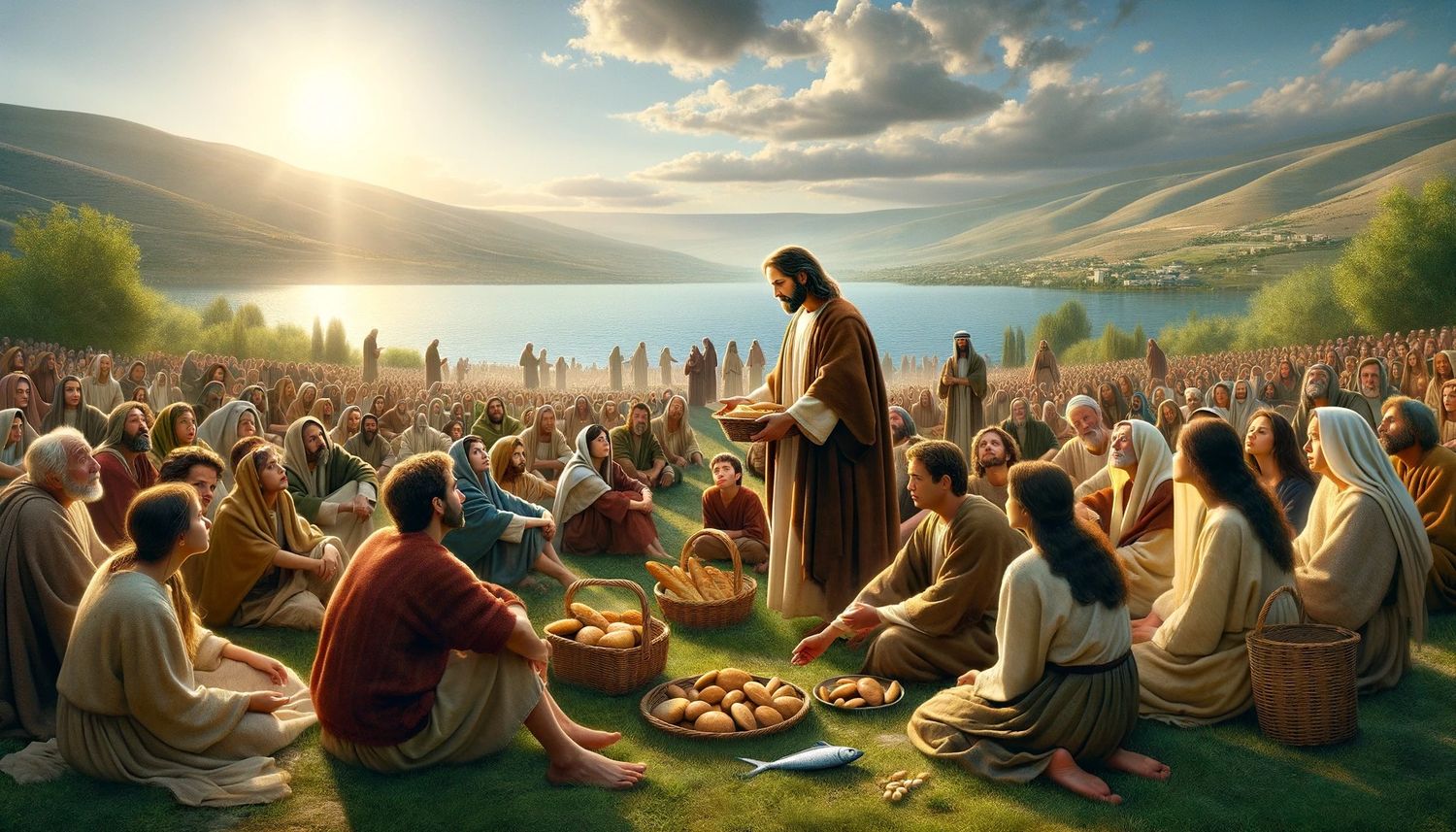Home>Christian Videos>Bible Stories>Why Is The Feeding Of The 5,000 In All Four Gospels?


Bible Stories
Why Is The Feeding Of The 5,000 In All Four Gospels?
Published: March 5, 2024
Peter Smith, Editorial Director at Christian.net, combines deep insights into faith, politics, and culture to lead content creation that resonates widely. Awarded for his contributions to religious discourse, he previously headed a major organization for religious communicators, enhancing dialogue on faith's societal impacts.
Explore the significance of the Feeding of the 5,000 in the Bible with a comparative analysis of all four Gospels. Uncover the deeper meaning behind this miraculous event.
(Many of the links in this article redirect to a specific reviewed product. Your purchase of these products through affiliate links helps to generate commission for Christian.net, at no extra cost. Learn more)
Table of Contents
Introduction
Why is the Feeding of the 5,000 in All Four Gospels? The Feeding of the 5,000 is a well-known miracle of Jesus, where he multiplied five loaves of bread and two fish to feed a multitude of people. This miraculous event is not only significant in the Christian faith but also holds a special place in the Gospels of Matthew, Mark, Luke, and John. Each of these accounts provides unique perspectives and details about the miracle, leading to the question of why this particular event is included in all four Gospels. Let's delve into the significance of the Feeding of the 5,000 in each Gospel and explore the reasons behind its presence in all four accounts.
Read more: Why Four Gospels?
The Feeding of the 5,000 in the Gospel of Matthew
In the Gospel of Matthew, the account of the Feeding of the 5,000 is found in Matthew 14:13-21. This narrative begins with Jesus withdrawing to a solitary place upon hearing about the death of John the Baptist. However, the crowds followed him, and despite his grief, Jesus was moved with compassion for them. The disciples, recognizing the need to provide food for the multitude, brought to Jesus five loaves of bread and two fish. Jesus then blessed the food, and miraculously, it was multiplied to feed the entire gathering, with twelve baskets of leftovers collected afterward.
Matthew's account emphasizes Jesus' compassion for the people and his ability to provide for their needs. It also highlights the disciples' role in the miracle, as they were the ones who brought the meager provisions to Jesus. This narrative in Matthew serves to demonstrate Jesus' divine power and his willingness to meet the physical needs of the people who sought him. The inclusion of this miracle in the Gospel of Matthew showcases Jesus as the compassionate provider, reinforcing his identity as the Messiah and the fulfillment of Old Testament prophecies.
The Feeding of the 5,000 in Matthew's Gospel not only serves as a demonstration of Jesus' miraculous abilities but also as a symbol of his role as the Bread of Life, a theme that is further developed in the Gospel. This event lays the foundation for Jesus' subsequent teachings about being the bread that gives eternal life, as recorded in Matthew 16:5-12. The significance of this miracle in Matthew's Gospel goes beyond the physical feeding of the multitude; it points to the spiritual sustenance that Jesus offers to all who come to him in faith.
The Feeding of the 5,000 in the Gospel of Matthew is a pivotal moment in Jesus' ministry, showcasing his compassion, power, and identity as the provider of both physical and spiritual nourishment. This account sets the stage for the deeper spiritual truths that Jesus imparts throughout the Gospel of Matthew, making it a crucial and impactful inclusion in this particular Gospel.
The Feeding of the 5,000 in the Gospel of Mark
In the Gospel of Mark, the account of the Feeding of the 5,000 is detailed in Mark 6:30-44. This narrative begins with Jesus and his disciples seeking a solitary place for rest after their ministry activities. However, the crowds followed them, and Jesus, moved with compassion, began to teach them. As the day turned to evening, the disciples urged Jesus to send the people away to find food in the surrounding villages. In response, Jesus instructed the disciples to feed the multitude with what they had, five loaves of bread and two fish. After blessing the food, Jesus multiplied it, and it was enough to satisfy the entire gathering, with twelve baskets of leftovers gathered afterward.
Mark's account of the Feeding of the 5,000 emphasizes Jesus' compassion for the people and his willingness to teach and provide for their needs. It also highlights the disciples' initial lack of understanding and their role in the distribution of the miraculous provisions. This narrative in Mark serves to demonstrate Jesus' authority over the physical elements and his ability to meet the needs of the people who sought him. The inclusion of this miracle in the Gospel of Mark reinforces Jesus' identity as the compassionate teacher and provider, echoing the themes of servanthood and humility that are prevalent throughout this Gospel.
The Feeding of the 5,000 in the Gospel of Mark serves as a powerful demonstration of Jesus' divine authority and his ability to satisfy the hunger of the masses, both physically and spiritually. This event sets the stage for Jesus' subsequent teachings about the true source of nourishment and the significance of faith in God's provision, as recorded in Mark 8:14-21. The significance of this miracle in Mark's Gospel extends beyond the immediate feeding of the multitude; it serves as a foundational moment in Jesus' ministry, illustrating his role as the ultimate provider and sustainer of all who come to him in faith.
The Feeding of the 5,000 in the Gospel of Mark is a pivotal event that showcases Jesus' compassion, authority, and identity as the source of both physical and spiritual nourishment. This account lays the groundwork for the deeper spiritual truths that Jesus imparts throughout the Gospel of Mark, making it a crucial and impactful inclusion in this particular Gospel.
The Feeding of the 5,000 in the Gospel of Luke
In the Gospel of Luke, the account of the Feeding of the 5,000 is found in Luke 9:10-17. This narrative begins with the return of the twelve disciples from their mission, and Jesus took them to a town called Bethsaida. However, the crowds learned of this and followed Jesus. Despite seeking solitude, Jesus welcomed them, spoke to them about the kingdom of God, and healed those in need of healing. As the day drew to a close, the disciples suggested sending the crowd away to find food and lodging. In response, Jesus instructed the disciples to give the crowd something to eat. They found five loaves of bread and two fish, and Jesus blessed the food, multiplied it, and the entire multitude was fed, with twelve baskets of leftovers collected afterward.
Luke's account of the Feeding of the 5,000 highlights Jesus' compassion for the people and his willingness to minister to their physical and spiritual needs. It also emphasizes the disciples' role in the distribution of the miraculous provisions and their initial lack of understanding. This narrative in Luke serves to demonstrate Jesus' concern for both the physical and spiritual well-being of the people who sought him. The inclusion of this miracle in the Gospel of Luke reinforces Jesus' identity as the compassionate healer and provider, echoing the themes of mercy and inclusivity that are prevalent throughout this Gospel.
The Feeding of the 5,000 in the Gospel of Luke serves as a powerful demonstration of Jesus' care for the multitude and his ability to meet their needs, both material and spiritual. This event sets the stage for Jesus' subsequent teachings about the kingdom of God and the significance of trusting in God's provision, as recorded in Luke 12:22-31. The significance of this miracle in Luke's Gospel goes beyond the immediate feeding of the multitude; it serves as a foundational moment in Jesus' ministry, illustrating his role as the ultimate provider and sustainer of all who come to him in faith.
The Feeding of the 5,000 in the Gospel of Luke is a pivotal event that showcases Jesus' compassion, ministry, and identity as the source of both physical and spiritual nourishment. This account lays the groundwork for the deeper spiritual truths that Jesus imparts throughout the Gospel of Luke, making it a crucial and impactful inclusion in this particular Gospel.
The Feeding of the 5,000 in the Gospel of John
In the Gospel of John, the account of the Feeding of the 5,000 is detailed in John 6:1-15. This narrative begins with Jesus traveling to the other side of the Sea of Galilee, followed by a large crowd because they saw the signs he was performing on the sick. As the Passover, a Jewish festival, was approaching, Jesus looked up and saw a great crowd coming toward him. He then asked Philip, one of his disciples, where they could buy bread to feed the people. Philip replied that it would take more than half a year's wages to buy enough bread for each one to have a bite. Andrew, another disciple, found a boy with five small barley loaves and two small fish, but questioned how far they would go among so many. Jesus then instructed the people to sit down, took the loaves, gave thanks, and distributed them to those who were seated. He did the same with the fish, and everyone had as much as they wanted. After everyone had eaten, Jesus instructed the disciples to gather the leftover pieces, filling twelve baskets with the fragments of the five barley loaves left by those who had eaten.
John's account of the Feeding of the 5,000 emphasizes Jesus' divine nature and his ability to provide abundantly for the physical needs of the people. It also highlights the disciples' initial disbelief and their role in the distribution of the miraculous provisions. This narrative in John serves to demonstrate Jesus' identity as the true bread from heaven, the source of eternal sustenance for all who believe in him. The inclusion of this miracle in the Gospel of John reinforces Jesus' identity as the Son of God and the fulfillment of God's redemptive plan for humanity.
The Feeding of the 5,000 in the Gospel of John serves as a powerful demonstration of Jesus' deity and his ability to satisfy the hunger of the masses, both physically and spiritually. This event sets the stage for Jesus' subsequent teachings about being the bread of life and the significance of partaking in him for eternal life, as recorded in John 6:25-59. The significance of this miracle in John's Gospel extends beyond the immediate feeding of the multitude; it serves as a foundational moment in Jesus' ministry, illustrating his role as the ultimate provider and sustainer of all who come to him in faith.
The Feeding of the 5,000 in the Gospel of John is a pivotal event that showcases Jesus' divine nature, provision, and identity as the source of both physical and spiritual nourishment. This account lays the groundwork for the deeper spiritual truths that Jesus imparts throughout the Gospel of John, making it a crucial and impactful inclusion in this particular Gospel.
Read more: Why Are The Gospels Called The Gospels
Reasons for the Inclusion of the Feeding of the 5,000 in All Four Gospels
-
Multifaceted Symbolism: The Feeding of the 5,000 holds profound symbolic significance, representing Jesus as the provider of physical and spiritual nourishment. Each Gospel emphasizes different aspects of this symbolism, contributing to a comprehensive portrayal of Jesus' divine nature and redemptive mission.
-
Demonstration of Jesus' Power: The miracle serves as a powerful demonstration of Jesus' divine authority over the natural elements, showcasing his ability to perform extraordinary acts that transcend human limitations. Its inclusion in all four Gospels underscores the unanimous testimony to Jesus' extraordinary power.
-
Teaching on Faith and Provision: The event provides a platform for Jesus to impart essential teachings on faith, trust in God's provision, and the true source of sustenance. Each Gospel presents unique insights into these teachings, enriching the overall understanding of Jesus' message.
-
Reinforcement of Jesus' Identity: By including the Feeding of the 5,000, all four Gospels reinforce Jesus' identity as the long-awaited Messiah, the Bread of Life, and the fulfillment of Old Testament prophecies. The consistent portrayal of Jesus in this light strengthens the foundational beliefs of the Christian faith.
-
Impact on Jesus' Ministry: The Feeding of the 5,000 marks a pivotal moment in Jesus' earthly ministry, signifying his compassion, care for the needy, and the inauguration of a new spiritual order. Its inclusion in all four Gospels highlights its enduring impact on Jesus' mission and the formation of his disciples.
-
Universal Relevance: The narrative of the Feeding of the 5,000 transcends cultural and geographical boundaries, resonating with people from diverse backgrounds. Its universal appeal and timeless message make it a crucial component of the Gospels, addressing the fundamental human needs for sustenance and spiritual fulfillment.
-
Historical Authenticity: The inclusion of the miracle in all four Gospels attests to its historical authenticity and significance in the life of Jesus. This unanimity among the Gospel accounts strengthens the credibility of the event and its enduring impact on the early Christian community.
-
Unity in Diversity: Despite the distinct theological emphases of each Gospel, the shared inclusion of the Feeding of the 5,000 reflects a unity in diversity, affirming the central role of this miraculous event in shaping the collective memory and understanding of Jesus' ministry among the early Christians.
-
Foreshadowing of the Eucharist: The miraculous feeding prefigures the institution of the Eucharist, where Jesus offers himself as the spiritual sustenance for believers. The inclusion of this event in all four Gospels lays the groundwork for understanding the deeper significance of the Eucharistic tradition in Christian worship.
-
Testimony to Jesus' Compassion: Above all, the inclusion of the Feeding of the 5,000 in all four Gospels serves as a resounding testimony to Jesus' boundless compassion, care for the marginalized, and his enduring legacy as the embodiment of God's love for humanity. This shared emphasis on Jesus' compassion reinforces the universal appeal of his message and mission.
The presence of the Feeding of the 5,000 in all four Gospels underscores its pivotal role in shaping the narrative of Jesus' life and ministry, offering diverse yet complementary perspectives that enrich the understanding of his identity, teachings, and enduring impact on the Christian faith.
Conclusion
The inclusion of the Feeding of the 5,000 in all four Gospels serves as a testament to the profound significance of this miraculous event in the life and ministry of Jesus. Each Gospel provides unique insights into the compassion, power, and identity of Jesus, enriching the collective understanding of his divine nature and redemptive mission. The multifaceted symbolism, demonstration of Jesus' power, teachings on faith and provision, reinforcement of his identity, impact on his ministry, universal relevance, historical authenticity, unity in diversity, foreshadowing of the Eucharist, and testimony to his compassion collectively underscore the enduring impact of the Feeding of the 5,000. This shared emphasis on the miraculous provision of physical and spiritual nourishment reinforces the universal appeal of Jesus' message and mission, transcending cultural and temporal boundaries. The inclusion of this pivotal event in all four Gospels not only affirms its historical authenticity but also highlights its enduring significance in shaping the foundational beliefs of the Christian faith.














